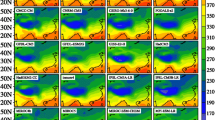Abstract
A large number of land surface models (LSMs) have been designed for use in atmospheric general circulation models (GCMs) and GCM modellers therefore have a large number of options when selecting an LSM for their GCM. This study provides information to aid LSM design choices. A framework within which sensitivity to LSM design can be tested is presented and a series of experiments carried out to investigate how general aspects of surface energy balance parametrisation affect land-atmosphere evaporation. Firstly, it is shown that a combination of surface energy balance complexity and aerodynamic parametrisation can be used to explain the gross simulation differences obtained in the Project for Intercomparison of Land-surface Parameterization Schemes (PILPS). Secondly, a simple surface energy balance parametrisation with a constant surface resistance is found to be as appropriate as more complex method for simulating annual, monthly and seasonally averaged diurnal cycles of evaporation. However, complex aspects of surface energy balance parametrisation (canopy interception, bare ground evaporation and canopy resistance) are shown to contain substantial geographic and daily functionality that is not present in the simpler parametrisation.
Similar content being viewed by others
Author information
Authors and Affiliations
Additional information
Received: 12 June 1998/Accepted: 24 December 1998
Rights and permissions
About this article
Cite this article
Desborough, C. Surface energy balance complexity in GCM land surface models. Climate Dynamics 15, 389–403 (1999). https://doi.org/10.1007/s003820050289
Issue Date:
DOI: https://doi.org/10.1007/s003820050289




